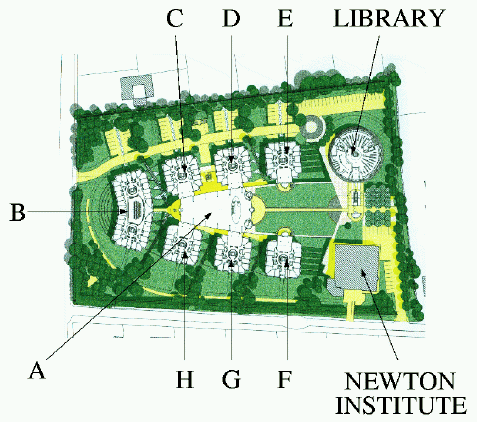Faulkes Institute for Geometry
Construction of Pavilion E has just finished; F,G and H will follow early next year.

Photograph taken on 19 October 2000 by Professor Geoffrey Grimmett from McAlpine's crane. The hole has become pavilion E.
In addition to funding the construction of the Gatehouse, Dr Dill Faulkes made another generous donation, towards the cost of an Institute for Geometry. This, together with further support from Nick Corfield, has made possible the construction of Pavilion E.

Professor Raymond Lickorish, Head of the Department of Pure Mathematics and Mathematical Statistics, writes:
In the repertoire of modern mathematics, the subject of Geometry still occupies a central key position. Geometrical thinking dominates a great deal of creative mathematical research, in which a new theory begins with an intuitive visual idea, about the placement of objects in space, that is then transformed into a rigorous logical argument. The ancient spirit of Euclidean Geometry, whereby a result is incontrovertibly proved from a stated set of axioms and previously proved theorems (to the profound satisfaction of its author), is still the essence of the whole of pure mathematics today. Interpreting Geometry as the part of mathematics motivated by the desire to understand the nature of different types of space, modern Geometry includes a variety of different topics which will be pursued by different, but overlapping, research groups within the Institute for Geometry. Within western civilisation, all these areas have developed, over many centuries, from classical Greek geometry. A deep appreciation of Euclidean Geometry is undoubtedly a necessity for modern geometers. The vibrant geometrical activity within the Institute will interact with the Millennium Mathematics Project, situated elsewhere in the Centre, to help encourage the teaching and learning of basic Geometry in British schools.
